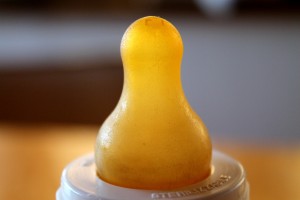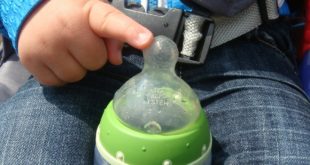Ask Anne…
 Question: I gave my baby several bottles of expressed breast milk when he first came home from the hospital because he was jaundiced and too sleepy to nurse well. Now, at 3 days my milk has come in and he’s not sleepy anymore, but I can’t get him to nurse. He takes the bottle fine but cries when I try to breastfeed him. I think he’s become nipple confused and I don’t know what to do.
Question: I gave my baby several bottles of expressed breast milk when he first came home from the hospital because he was jaundiced and too sleepy to nurse well. Now, at 3 days my milk has come in and he’s not sleepy anymore, but I can’t get him to nurse. He takes the bottle fine but cries when I try to breastfeed him. I think he’s become nipple confused and I don’t know what to do.
Answer: The mechanics of breast and bottle feeding are quite different. When a baby nurses, his tongue and jaws must work together rhythmically, cupping his tongue under the areola, and pressing it up against the roof of his mouth. This flattens and elongates the tissue around the nipple. He then drops the back of his tongue to form a groove for the milk to flow from the nipple to his throat. He swallows, then takes a breath. His lips are flanged out tightly around the breast to form a tight seal.
When a baby drinks from a bottle, the milk gushes out (you’ll notice that the milk drips out if you hold a bottle upside down). In order to keep from choking, he lifts his tongue uses it to block the flow of milk. He purses his lips around the hard rubber nipple, and he doesn’t have to use his jaws at all. There is a constant flow of milk that he doesn’t have to work for, unlike during breastfeeding, where the milk ‘lets down’ initially, then slows to a trickle, and the process repeats as the baby sucks harder and longer. This occurs several times during a feeding, and is one of the reasons breastfed babies are less likely to become obese than bottle-fed babies: they regulate their own intake by how long and vigorously they suck. Bottle-fed infants will often finish a bottle not because they are hungry, but because they love to suck, and the milk flows so easily.
The risk of nipple confusion , whether by introducing a bottle or pacifier, is greatest during the early days of nursing. The longer you wait to introduce artificial nipples, the less risk there is of confusing your baby.
Breastfeeding is a learned behavior, in most cases, although there are some babies who seem to be born knowing exactly what to do. Although sucking is a newborn reflex, the mechanics of effective latching on aren’t. It usually takes a couple of weeks, and sometimes longer, for mothers and babies to get really good at nursing. By that time, any problems you had in the beginning, such as engorgement or nipple soreness, should be pretty much resolved, and your baby’s pattern of weight gain should be established.
If your baby does have trouble switching back and forth between breast and bottle, here are some things you can do to help:
- Be very patient and persistent. Remember that your baby is new at all this, and is just as frustrated as you are (if not more) and needs time to learn how to nurse at the breast effectively.
- Try to avoid the use of artificial nipples as much as possible. There are lots of ways to get milk into your baby besides bottle nipples, including cup feeding, syringe feeding, or tube feeding.
- Offer the breast frequently, and don’t wait til he is frantically hungry. Babies are likely to get more frustrated if they are starving, and may be more resistant to working at getting milk out of the breast when they are used to the instant, steady flow of milk from the bottle.
- Use nipple stimulation, warm compresses, and breast massage to get your milk to let-down before you put your baby to the breast so that the milk will be available to him immediately without him having to wait for the milk ejection reflex to occur.
- “Reward” your baby by dripping some milk into his mouth while you are trying to get him to take the breast. That can encourage him to continue his efforts to latch on and continue sucking.
- Make sure that he gets enough to eat while your are working at getting him to take the breast. Supplement him as necessary, using your expressed milk if possible, and formula if needed. If he is stressed and hungry, he is not going to have the energy he needs in order to breastfeed effectively.
- Pay careful attention to latch on and positioning. Make sure your baby opens wide like a yawn, and takes not only the nipple but also a good portion of the dark area around the nipple (the areola) in his mouth as well.
- Try nursing him when he is sleepy. Many babies who refuse the breast at other times will nurse when they are tucked in bed with you at bed or nap time and there are no distractions.
- Try some of the suggestions in the article Nursing Strike, including skin to skin contact, nursing in the bathtub, nursing while in motion (rocking or walking), and trying different positions.
The most important thing to remember is that once babies get it all figured out, they actually prefer nursing over bottle feeding. After your baby gets the hang of doing both, he will be able to switch back and forth easily and the whole nipple confusion will be nothing but a bad memory. It just takes patience and perseverance on your part, and he will get the hang of it.
Anne Smith, IBCLC
Breastfeeding Basics
 Breastfeeding Basics
Breastfeeding Basics




